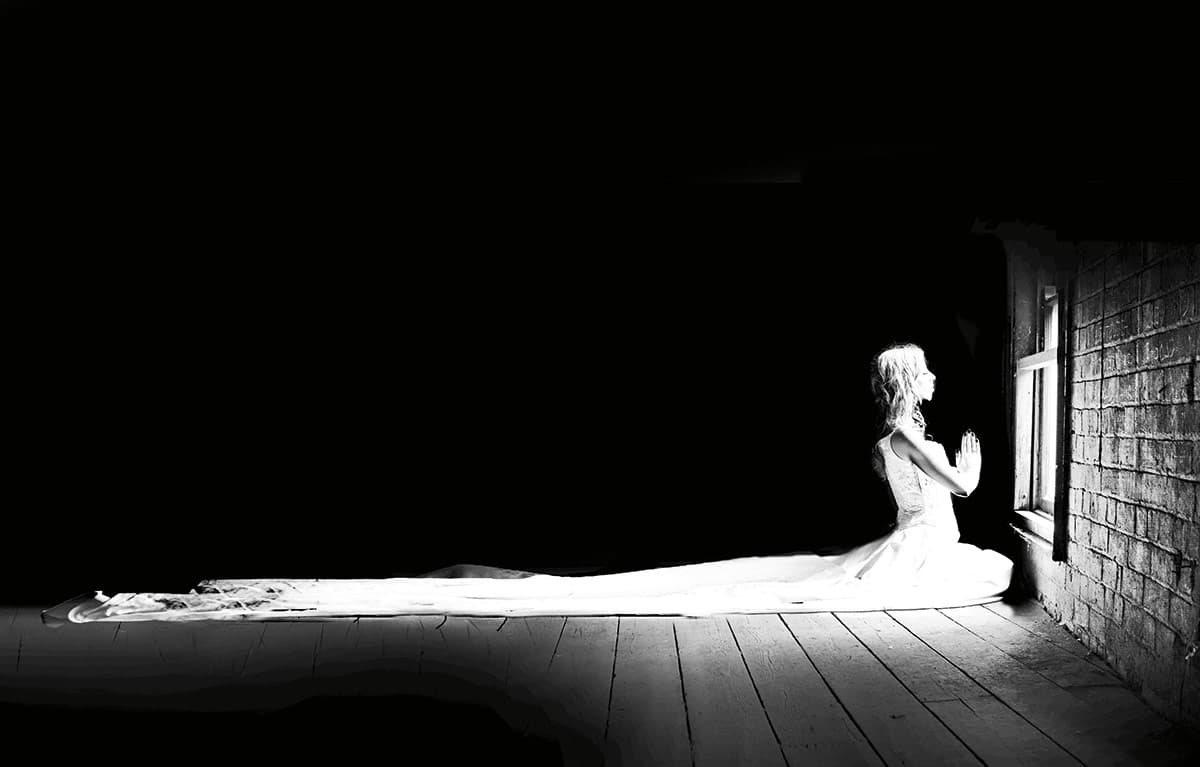The technical side of photography is not the only thing affected by the rapid movement of the digital age, as where and how we source our models has changed too. Increasingly, we are spending more time online to communicate, network and share our work. Over the years I have been active on many image-based websites, all with the aim to network, source models and grow my business.
Many people are aware of Flickr, 500px, Behance and DeviantArt. Using the internet to showcase and network is a fundamental part of photography, and sites like Model Mayhem and Purestorm have become a vital part of many photographers’ daily routines. Now we have PurplePort, an online platform that allows photographers and models to connect and collaborate. Just as people check their Twitter and Facebook feeds, photographers and models are checking PurplePort messages.
As new social media sites appear, I tend to join them. They are either free or very low cost with the options of upgrading, and you never know where the next big social push is going to be. I enjoyed my free account at PurplePort, but never got into the deeper use of the platform – such as involvement in the forums or community sides of the site. I was basically a light user who dipped in now and then to say ‘Hi’ and contact a model I couldn’t find on Facebook when casting outside of agents.
Online communities
I am sure that I am not alone when I say I have been somewhat wary of joining online communities, especially photography-related ones. ‘Trolling’ is a nasty buzzword these days, and it only takes a second to see the damage that can occur online. Why do I want my images online where people can comment and mock me? After a while, I deleted my account. I didn’t want to be judged or start judging others.
As a professional photographer, my main concern was the happiness of my clients. I didn’t want to read that someone online thought my photo was wrongly cropped. There is something in the back of my head that just does not sit well in this era of the keyboard warrior and the lack of transparency that online communities breed.
Models and photographers set up accounts in fake names and enjoy as much anonymity as they like, for both good and bad. After all, this is the internet, and you can be anything you want online. I think it would be safe to say that overall, online modelling and photography sites don’t have the friendliest reputation for newbie photographers as a safe haven to mature and grow.
Personally, I have had both good and bad moments dealing with the online communities. My account was just sitting there unloved and my images getting zero attention. It seemed like the forums were full of people moaning and fighting. A community of young girls and photographers is always going to be fraught with problems – the mix of hairspray and egos can quickly create a toxic environment if left unattended and unchecked.
Recently I came back to Purple Port. I decided to take a proper look into the community and invest some time into understanding and trying to see if I was missing anything. The site was growing and growing. It all came to a head when a model asked me for my ‘PP’ account; she was shocked when I said I didn’t have one and she questioned if I was a photographer or not. I simply suggested she look at my website. I still did not get a premium account (which gives you more access to statistics and lets you upload more images).
Over a few days I had someone guide me through the do’s and don’ts of PurplePort: how to get the best out of it and how I could benefit from it. As a result, I quickly came to the conclusion that since my first time on the site, I had been doing it all wrong. The first thing I had to understand is that PurplePort is not a place to make money, unless you are a model. On PurplePort money flows one way: photographer to model. If you’re a photographer looking for work you are in the wrong place, and if you are a photographer looking to feed your ego you’re going to have a hard time on the site. However, PurplePort works where other networking sites fail; when you lower your guard and participate in the forums, you can get much more out of the site.
It seems many of my first conclusions about PurplePort were pre-judgmental views and in some cases wrong. Overall, the community is a vibrant one where you can ask open questions, and get constructive advice – as well as give it.
For the models this is very useful and can be vital in terms of safety, while checks are in place to keep the intended tone and nature of the site. Overall, my view is this: with social networking and particularly on PurplePort, you will get out exactly what you put in.
Dave talks to Purpleport’s founder Russ Freeman…
Behind the site: Interview with founder Russ Freeman
After using PurplePort for a month or so, and as the site just breaks the 22,000 active-members marker, I spoke to owner and CEO Russ Freeman about how it came to be, and what it takes to build and manage such an online community. Among other things, I wanted to find out why PurplePort works in the way it does, and what makes it different from other networking sites from the owner’s viewpoint.
Amateur Photographer: How would you describe the website and what were the initial intentions for the site from its founding members?
Russ Freeman: PurplePort is a social networking and collaboration tool for models, photographers and related creatives. When designing the service we hijacked and adapted lots of designs and ideas from a variety of websites including Flickr, Tumblr, Twitter and Facebook. We spent a few months going through our competitors’ sites and applying the good ideas they had and combining them with ideas from elsewhere.
We wanted to design a service that would help you network and get noticed – simple things, such as allowing all images uploaded to be seen in one long list; seeing the recently joined members; making it easy to search by location rather than by regions; making our groups approachable by policing them well; and encouraging people to join in by sending helpful notifications. We even have a Your Account Health page, where you can get tips.
Three years in and we have lots of concepts we haven’t implemented yet and lots of designs for features that will help people connect, get together and create beautiful photos. PurplePort is definitely an ongoing project in this respect.
AP: Today PurplePort has more than 22,000 active members. What is the split between photographers, models and other creatives? What is the creative vibe of the site and what are new members going to enjoy most in the site?
RF: Around 35% of the members are models, 57% are photographers and everyone else makes up the remainder. This seems to be the same across all similar services.
I don’t think there is any one overall creative vibe. People join looking to achieve their own goals, whether that’s a fashion model looking for paid work or a student make-up artist wishing to collaborate with other creatives. Everyone appears to find his or her own thing.
If I were a new member, I’d certainly enjoy the massive amount of activity on the site. This is a service with so much going on. I still find it amazing to see so many inspiring photos and creative people, and so much willingness to share and collaborate. I’ve loved that right from the beginning and I still love it now.
AP: What does the future look like for the site and what are the plans for continuing to grow the forums that are quite active? As with all internet sites and forums, they can be subject to trolling behaviour – what measures do you have in place to control this?
RF: To be honest, we don’t need to do anything major or specific with the groups as they just continue to grow all on their own. This applies equally to the activity in official PurplePort-created groups as well as the member-created groups. On PurplePort we have 230 groups of which only 30 are official site-created groups. You can leave or join groups as you wish.
We have very strict policies for what gets posted in the groups. This varies from content that simply does not belong on PurplePort as well as content posted in the wrong groups. Our members are encouraged to report anything posted that they think isn’t suitable or can report members to us who they think are behaving unprofessionally. We obviously take our members’ safety very seriously. Everyone needs to feel they are in a safe and supportive environment to collaborate.
As for the future of the site, we’re just loving seeing it grow and seeing our members using the site with all its current features. As time goes on, with more members, more sharing and even more features, we are giving members new ways to share work and collaborate. It’s a very exciting stage.
AP: It seems like the site has a very wide range of styles and ability levels, so how do you cater for them all?
RF: We do nothing – the system takes care of itself. Sometimes people of differing levels or skills do butt heads and we step in to help resolve the issue. However, that’s quite rare. PurplePort is a site that caters to members of all skill levels, and we encourage our members to support one another, be it through the groups we created for sharing a shoot, constructive image critique, or the features we’ve built in where members can specify they are willing to mentor others or looking to be mentored. We want everyone who joins to be able to grow and improve, and enjoy creating wonderful images.
AP: As a site that handles thousands of images, can you track the information about the photos? What are some of the more fun facts about the seeing the back end data? Can you track to see which cameras are the best or most used? Can you tell who the best models are or track current trends in photography styles?
RF: Ha! You want me to say something like, ‘The best images are shot using Nikon’. No, we don’t track that kind of information. We have it, but we don’t do anything with it, although perhaps we should.
Tracking styles is hugely subjective, as I’m sure you know. What I think is fashion you might see as bland; what I think is art you might see as nonsense.
Our members can browse photos on the keywords they have been tagged with and collect images into lists to look at again at a later date for inspiration. We also have gadgets such as ‘random’ and the ‘most popular images’ list that looks at the number of member-loves an image has received over time and then displays them in an ever-changing gallery.
We also run a daily competition where members can upload photos on a theme and vote for a winner, which seems to be a hugely popular and well-used feature. We also have our famous Front Page Image (FPI) system that displays a range of great work selected to be featured on the front page of the website from our team of volunteers, the PurplePort Community Team.
This was originally set up with the purpose of advertising the great work available on the site to potential new members when they first arrive at PurplePort.com. Although this is still the primary function of the system, it has become somewhat of an online sensation, with members regularly sharing and seeking out their latest FPIs.
AP: You have a system similar to Facebook where people can like and comment on images. It would be fantastic to see some of the more popular images on the site and the people responsible for creating them.
RF: Popularity, whether it’s through people loving an image, adding it to collections, commenting on the image, or how many views an image gets, is no measure of whether the image is a good one. Again, it’s so intensely subjective.
However, we do have the systems I mentioned before, such as the most popular image and FPI gadgets and a ‘Yesterday love’ page that shows the most commented and most-loved images, and most-viewed profiles. Finally, a great way to see popular images is by following #PurplePort on Twitter.
Try out Purpleport for yourself at purpleport.com
















